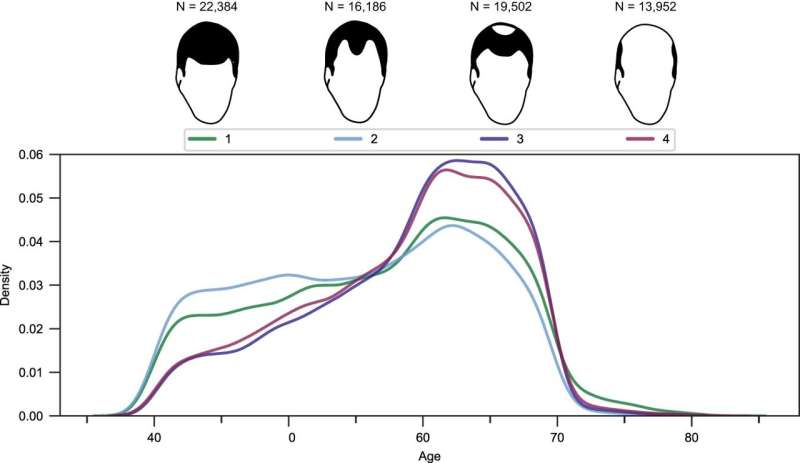This article has been reviewed according to Science X's editorial process and policies. Editors have highlighted the following attributes while ensuring the content's credibility:
fact-checked
peer-reviewed publication
proofread
Study identifies rare gene variants that play a role in hereditary male hair loss

Previous research into male pattern hair loss, also termed androgenetic alopecia, has implicated multiple common genetic variants. Human geneticists from the University Hospital of Bonn (UKB) and by the Transdisciplinary Research Unit "Life & Health" of the University of Bonn have now performed a systematic investigation of the extent to which rare genetic variants may also contribute to this disorder.
They analyzed the genetic sequences of 72,469 male participants from the UK Biobank project. The analyses identified five significantly associated genes, and further corroborated genes implicated in previous research. The results have been published in Nature Communications.
Male-pattern hair loss is the most common form of hair loss in men, and is largely attributable to hereditary factors. Current treatment options and risk prediction are suboptimal, thus necessitating research into the genetic underpinnings of the condition.
To date, studies worldwide have focused primarily on common genetic variants, and have implicated more than 350 genetic loci, in particular the androgen receptor gene, which is located on the maternally inherited X chromosome. In contrast, the contribution to this common condition of rare genetic variants has traditionally been assumed to be low. However, systematic analyses of rare variants have been lacking.
"Such analyses are more challenging as they require large cohorts, and the genetic sequences must be captured base by base, e.g., through genome or exome sequencing of affected individuals," explained first author Sabrina Henne, who is a doctoral student at the Institute of Human Genetics at the UKB and the University of Bonn.
The statistical challenge lies in the fact that these rare genetic variants may be carried by very few, or even single, individuals. "That is why we apply gene-based analyses that first collapse variants on the basis of the genes in which they are located," explained corresponding author PD Dr. Stefanie Heilmann-Heimbach, who is a research group leader at the Institute of Human Genetics at the UKB at the University of Bonn.
Among other methods, the Bonn researchers used a type of sequence kernel association test (SKAT), which is a popular method for detecting associations with rare variants, as well as GenRisk, which is a method developed at the Institute of Genomic Statistics and Bioinformatics (IGSB) at the UKB and the University of Bonn.
Possible relevance of rare variants in male-pattern hair loss
The research involved the analysis of genetic sequences from 72,469 male UK Biobank participants. Within this extensive data set, Bonn geneticists, together with researchers from the IGSB and the Center for Human Genetics at the University Hospital Marburg, examined rare gene variants that occur in less than one percent of the population.
Using modern bioinformatic and statistical methods, they found associations between male-pattern hair loss and rare genetic variants in the following five genes: EDA2R, WNT10A, HEPH, CEPT1, and EIF3F.
Prior to the analyses, EDA2R and WNT10A were already considered candidate genes, as based on previous analyses of common variants.
"Our study provides further evidence that these two genes play a role, and that this occurs through both common and rare variants," explained Dr. Stefanie Heilmann-Heimbach. Similarly, HEPH is located in a genetic region that has already been implicated by common variants, namely the EDA2R/Androgen receptor, which is a region that has consistently shown the strongest association with male-pattern hair loss in past association studies.
"However, HEPH itself has never been considered as a candidate gene. Our study suggests that it may also play a role," explained Sabrina Henne.
"The genes CEPT1 and EIF3F are located in genetic regions that have not yet been associated with male-pattern hair loss. They are thus entirely new candidate genes, and we hypothesize that rare variants within these genes contribute to the genetic predisposition. HEPH, CEPT1, and EIF3F represent highly plausible new candidate genes, given their previously described role in hair development and growth."
Furthermore, the results of the study suggest that genes that are known to cause rare inherited diseases affecting both skin and hair (such as the ectodermal dysplasias) may also play a role in the development of male-pattern hair loss.
The researchers hope that the puzzle pieces they have discovered will improve understanding of the causes of hair loss, and thus facilitate reliable risk prediction and improved treatment strategies.
More information: Sabrina Katrin Henne et al, Analysis of 72,469 UK Biobank exomes links rare variants to male-pattern hair loss, Nature Communications (2023). DOI: 10.1038/s41467-023-41186-w





















